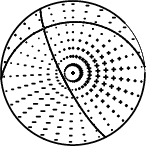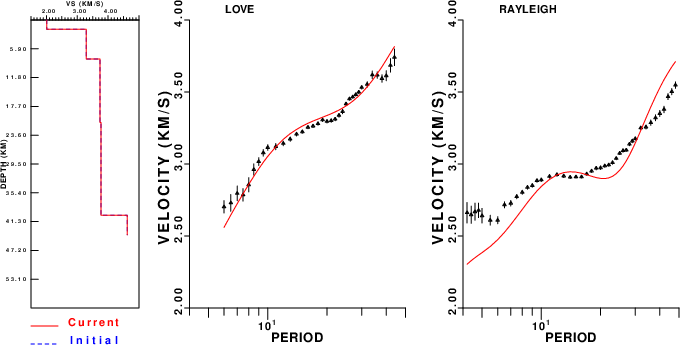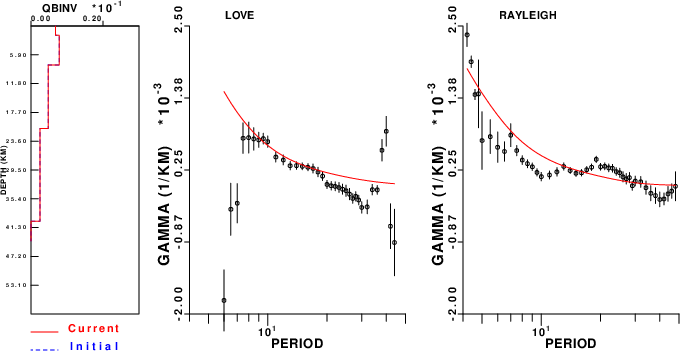Location
Location ANSS
The ANSS event ID is uw10701498 and the event page is at
https://earthquake.usgs.gov/earthquakes/eventpage/uw10701498/executive.
2006/10/08 02:48:27 46.850 -121.600 1.6 4.5 Washington
Focal Mechanism
USGS/SLU Moment Tensor Solution
ENS 2006/10/08 02:48:27:0 46.85 -121.60 1.6 4.5 Washington
Stations used:
CN.HNB CN.HOPB CN.PGC CN.PNT IU.COR UO.EUO UW.HEBO UW.HOOD
UW.MEGW UW.OFR UW.TOLO
Filtering commands used:
cut o DIST/3.3 -40 o DIST/3.3 +50
rtr
taper w 0.1
hp c 0.03 n 3
lp c 0.06 n 3
Best Fitting Double Couple
Mo = 3.55e+22 dyne-cm
Mw = 4.30
Z = 13 km
Plane Strike Dip Rake
NP1 145 74 127
NP2 255 40 25
Principal Axes:
Axis Value Plunge Azimuth
T 3.55e+22 47 94
N 0.00e+00 36 314
P -3.55e+22 20 208
Moment Tensor: (dyne-cm)
Component Value
Mxx -2.41e+22
Mxy -1.42e+22
Mxz 8.89e+21
Myy 9.35e+21
Myz 2.31e+22
Mzz 1.48e+22
--------------
----------------------
##--------------------------
####--------------------------
######--------#############-------
########--######################----
########--##########################--
######------###########################-
#####-------############################
####----------############################
###-------------############## #########
##---------------############# T #########
#-----------------############ #########
------------------######################
--------------------####################
--------------------##################
---------------------###############
-------- -----------############
------ P -------------########
----- ---------------#####
----------------------
--------------
Global CMT Convention Moment Tensor:
R T P
1.48e+22 8.89e+21 -2.31e+22
8.89e+21 -2.41e+22 1.42e+22
-2.31e+22 1.42e+22 9.35e+21
Details of the solution is found at
http://www.eas.slu.edu/eqc/eqc_mt/MECH.NA/20061008024827/index.html
|
Preferred Solution
The preferred solution from an analysis of the surface-wave spectral amplitude radiation pattern, waveform inversion or first motion observations is
STK = 255
DIP = 40
RAKE = 25
MW = 4.30
HS = 13.0
The NDK file is 20061008024827.ndk
The waveform inversion is preferred.
Moment Tensor Comparison
The following compares this source inversion to those provided by others. The purpose is to look for major differences and also to note slight differences that might be inherent to the processing procedure. For completeness the USGS/SLU solution is repeated from above.
| SLU |
UW |
USGS/SLU Moment Tensor Solution
ENS 2006/10/08 02:48:27:0 46.85 -121.60 1.6 4.5 Washington
Stations used:
CN.HNB CN.HOPB CN.PGC CN.PNT IU.COR UO.EUO UW.HEBO UW.HOOD
UW.MEGW UW.OFR UW.TOLO
Filtering commands used:
cut o DIST/3.3 -40 o DIST/3.3 +50
rtr
taper w 0.1
hp c 0.03 n 3
lp c 0.06 n 3
Best Fitting Double Couple
Mo = 3.55e+22 dyne-cm
Mw = 4.30
Z = 13 km
Plane Strike Dip Rake
NP1 145 74 127
NP2 255 40 25
Principal Axes:
Axis Value Plunge Azimuth
T 3.55e+22 47 94
N 0.00e+00 36 314
P -3.55e+22 20 208
Moment Tensor: (dyne-cm)
Component Value
Mxx -2.41e+22
Mxy -1.42e+22
Mxz 8.89e+21
Myy 9.35e+21
Myz 2.31e+22
Mzz 1.48e+22
--------------
----------------------
##--------------------------
####--------------------------
######--------#############-------
########--######################----
########--##########################--
######------###########################-
#####-------############################
####----------############################
###-------------############## #########
##---------------############# T #########
#-----------------############ #########
------------------######################
--------------------####################
--------------------##################
---------------------###############
-------- -----------############
------ P -------------########
----- ---------------#####
----------------------
--------------
Global CMT Convention Moment Tensor:
R T P
1.48e+22 8.89e+21 -2.31e+22
8.89e+21 -2.41e+22 1.42e+22
-2.31e+22 1.42e+22 9.35e+21
Details of the solution is found at
http://www.eas.slu.edu/eqc/eqc_mt/MECH.NA/20061008024827/index.html
|
University of Washington First Motion Solution
Fault Plane Parameters for 06100802482c
Fault Choice 1 Fault Choice 2
Strike(deg) 120.0 277.0
Dip(deg) 65.0 27.0
Rake(deg) 100.2 69.3
Fault Type reverse reverse
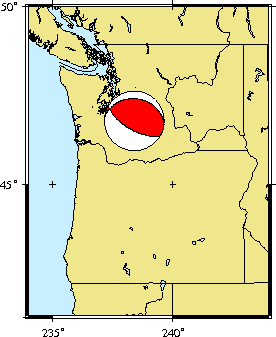
|
Context
The left panel of the next figure presents the focal mechanism for this earthquake (red) in the context of other nearby events (blue) in the SLU Moment Tensor Catalog. The right panel shows the inferred direction of maximum compressive stress and the type of faulting (green is strike-slip, red is normal, blue is thrust; oblique is shown by a combination of colors). Thus context plot is useful for assessing the appropriateness of the moment tensor of this event.
Waveform Inversion using wvfgrd96
The focal mechanism was determined using broadband seismic waveforms. The location of the event (star) and the
stations used for (red) the waveform inversion are shown in the next figure.

|
|
Location of broadband stations used for waveform inversion
|
The program wvfgrd96 was used with good traces observed at short distance to determine the focal mechanism, depth and seismic moment. This technique requires a high quality signal and well determined velocity model for the Green's functions. To the extent that these are the quality data, this type of mechanism should be preferred over the radiation pattern technique which requires the separate step of defining the pressure and tension quadrants and the correct strike.
The observed and predicted traces are filtered using the following gsac commands:
cut o DIST/3.3 -40 o DIST/3.3 +50
rtr
taper w 0.1
hp c 0.03 n 3
lp c 0.06 n 3
The results of this grid search are as follow:
DEPTH STK DIP RAKE MW FIT
WVFGRD96 1.0 335 35 -40 4.04 0.2929
WVFGRD96 2.0 335 30 -35 4.15 0.3225
WVFGRD96 3.0 335 85 50 4.16 0.3342
WVFGRD96 4.0 335 90 50 4.17 0.3575
WVFGRD96 5.0 160 80 60 4.22 0.3865
WVFGRD96 6.0 165 75 60 4.23 0.4158
WVFGRD96 7.0 170 70 60 4.24 0.4363
WVFGRD96 8.0 165 75 60 4.29 0.4455
WVFGRD96 9.0 170 70 60 4.30 0.4614
WVFGRD96 10.0 170 70 60 4.30 0.4709
WVFGRD96 11.0 260 35 30 4.29 0.4781
WVFGRD96 12.0 260 35 30 4.30 0.4821
WVFGRD96 13.0 255 40 25 4.30 0.4827
WVFGRD96 14.0 255 40 20 4.30 0.4813
WVFGRD96 15.0 255 40 20 4.31 0.4769
WVFGRD96 16.0 255 40 20 4.31 0.4702
WVFGRD96 17.0 250 45 10 4.32 0.4635
WVFGRD96 18.0 245 45 0 4.32 0.4546
WVFGRD96 19.0 240 50 -15 4.33 0.4473
WVFGRD96 20.0 240 50 -15 4.34 0.4392
WVFGRD96 21.0 240 50 -15 4.35 0.4301
WVFGRD96 22.0 240 50 -15 4.36 0.4209
WVFGRD96 23.0 240 50 -15 4.36 0.4112
WVFGRD96 24.0 240 50 -15 4.37 0.4013
WVFGRD96 25.0 240 50 -15 4.37 0.3913
WVFGRD96 26.0 240 50 -15 4.38 0.3810
WVFGRD96 27.0 240 50 -15 4.38 0.3704
WVFGRD96 28.0 240 50 -15 4.39 0.3595
WVFGRD96 29.0 240 50 -15 4.39 0.3486
The best solution is
WVFGRD96 13.0 255 40 25 4.30 0.4827
The mechanism corresponding to the best fit is

|
|
Figure 1. Waveform inversion focal mechanism
|
The best fit as a function of depth is given in the following figure:

|
|
Figure 2. Depth sensitivity for waveform mechanism
|
The comparison of the observed and predicted waveforms is given in the next figure. The red traces are the observed and the blue are the predicted.
Each observed-predicted component is plotted to the same scale and peak amplitudes are indicated by the numbers to the left of each trace. A pair of numbers is given in black at the right of each predicted traces. The upper number it the time shift required for maximum correlation between the observed and predicted traces. This time shift is required because the synthetics are not computed at exactly the same distance as the observed, the velocity model used in the predictions may not be perfect and the epicentral parameters may be be off.
A positive time shift indicates that the prediction is too fast and should be delayed to match the observed trace (shift to the right in this figure). A negative value indicates that the prediction is too slow. The lower number gives the percentage of variance reduction to characterize the individual goodness of fit (100% indicates a perfect fit).
The bandpass filter used in the processing and for the display was
cut o DIST/3.3 -40 o DIST/3.3 +50
rtr
taper w 0.1
hp c 0.03 n 3
lp c 0.06 n 3

|
|
Figure 3. Waveform comparison for selected depth. Red: observed; Blue - predicted. The time shift with respect to the model prediction is indicated. The percent of fit is also indicated. The time scale is relative to the first trace sample.
|

|
|
Focal mechanism sensitivity at the preferred depth. The red color indicates a very good fit to the waveforms.
Each solution is plotted as a vector at a given value of strike and dip with the angle of the vector representing the rake angle, measured, with respect to the upward vertical (N) in the figure.
|
A check on the assumed source location is possible by looking at the time shifts between the observed and predicted traces. The time shifts for waveform matching arise for several reasons:
- The origin time and epicentral distance are incorrect
- The velocity model used for the inversion is incorrect
- The velocity model used to define the P-arrival time is not the
same as the velocity model used for the waveform inversion
(assuming that the initial trace alignment is based on the
P arrival time)
Assuming only a mislocation, the time shifts are fit to a functional form:
Time_shift = A + B cos Azimuth + C Sin Azimuth
The time shifts for this inversion lead to the next figure:

The derived shift in origin time and epicentral coordinates are given at the bottom of the figure.
Surface-Wave Focal Mechanism
The following figure shows the stations used in the grid search for the best focal mechanism to fit the surface-wave spectral amplitudes of the Love and Rayleigh waves.

|
|
Location of broadband stations used to obtain focal mechanism from surface-wave spectral amplitudes
|
The surface-wave determined focal mechanism is shown here.
NODAL PLANES
STK= 152.99
DIP= 77.80
RAKE= 117.63
OR
STK= 264.98
DIP= 30.01
RAKE= 25.00
DEPTH = 9.0 km
Mw = 4.35
Best Fit 0.8368 - P-T axis plot gives solutions with FIT greater than FIT90
Surface-wave analysis
Surface wave analysis was performed using codes from
Computer Programs in Seismology, specifically the
multiple filter analysis program do_mft and the surface-wave
radiation pattern search program srfgrd96.
Data preparation
Digital data were collected, instrument response removed and traces converted
to Z, R an T components. Multiple filter analysis was applied to the Z and T traces to obtain the Rayleigh- and Love-wave spectral amplitudes, respectively.
These were input to the search program which examined all depths between 1 and 25 km
and all possible mechanisms.
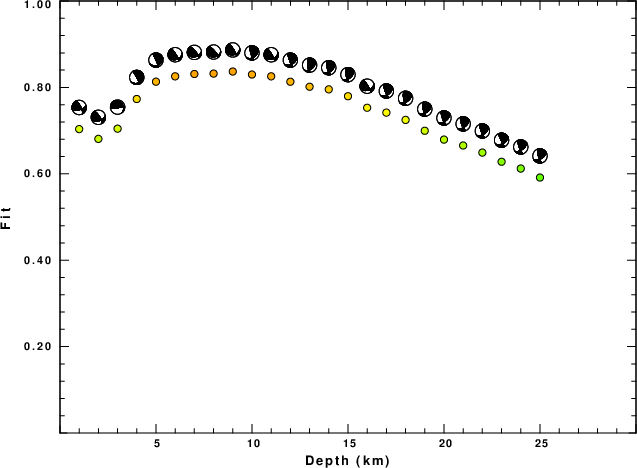
|
|
Best mechanism fit as a function of depth. The preferred depth is given above. Lower hemisphere projection
|
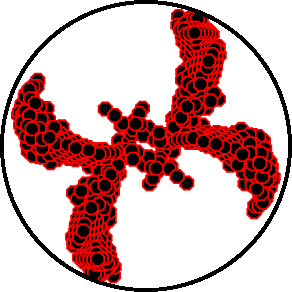
|
|
Pressure-tension axis trends. Since the surface-wave spectra search does not distinguish between P and T axes and since there is a 180 ambiguity in strike, all possible P and T axes are plotted. First motion data and waveforms will be used to select the preferred mechanism. The purpose of this plot is to provide an idea of the
possible range of solutions. The P and T-axes for all mechanisms with goodness of fit greater than 0.9 FITMAX (above) are plotted here.
|
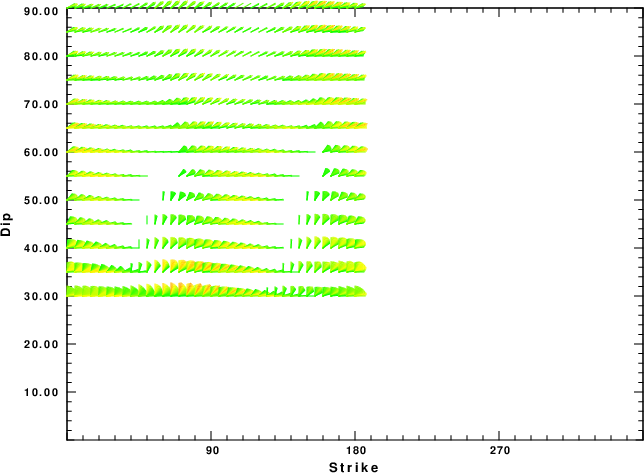
|
|
Focal mechanism sensitivity at the preferred depth. The red color indicates a very good fit to the Love and Rayleigh wave radiation patterns.
Each solution is plotted as a vector at a given value of strike and dip with the angle of the vector representing the rake angle, measured, with respect to the upward vertical (N) in the figure. Because of the symmetry of the spectral amplitude rediation patterns, only strikes from 0-180 degrees are sampled.
|
Love-wave radiation patterns
Rayleigh-wave radiation patterns









